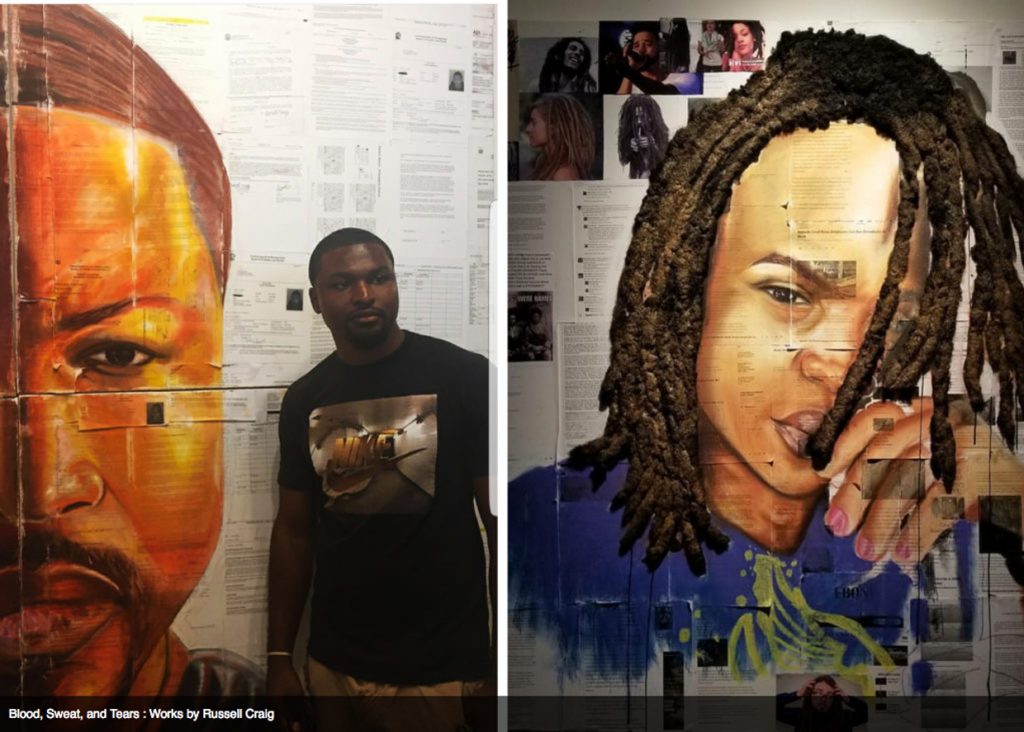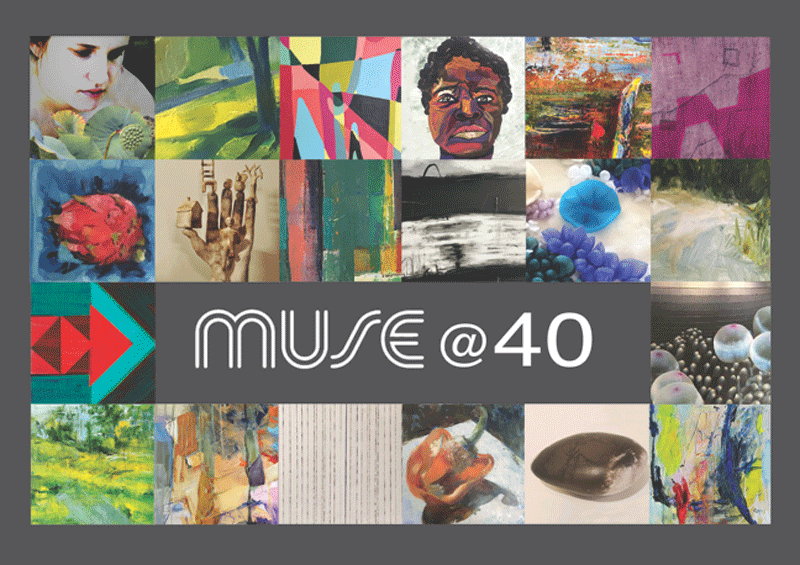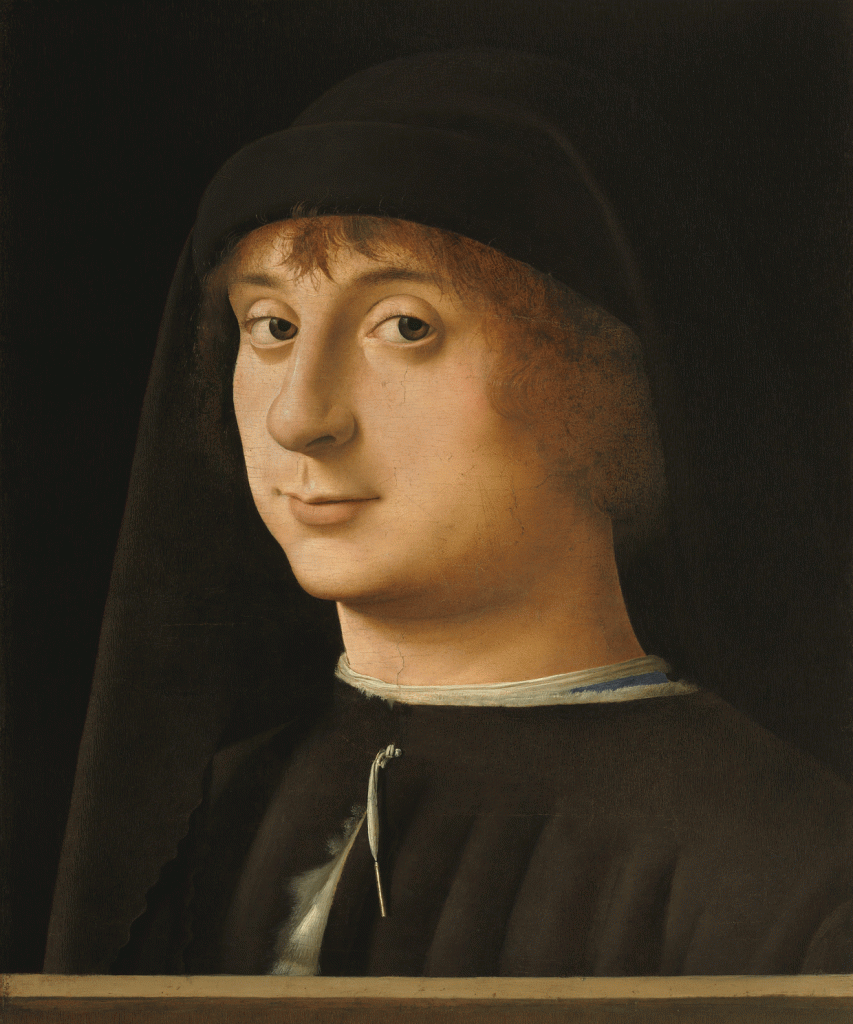 Portrait of a Young Gentleman, 1474. Antonello da Messina (Antonello di Giovanni di Michele de Antonio), Italian. Oil on panel, 12 5/8 x 10 11/16 inches. Philadelphia Museum of Art, John G. Johnson Collection, 1917.
Portrait of a Young Gentleman, 1474. Antonello da Messina (Antonello di Giovanni di Michele de Antonio), Italian. Oil on panel, 12 5/8 x 10 11/16 inches. Philadelphia Museum of Art, John G. Johnson Collection, 1917.
Old Masters Now: Celebrating the Johnson Collection
November 3, 2017 – February 19, 2018
Art gives us real delight only when the eye derives pleasure from what is really worthy.—John G. Johnson, from his art and travel memoir, Sight-Seeing in Berlin and Holland among Pictures (1892)
The Philadelphia Museum of Art presents Old Masters Now: Celebrating the Johnson Collection, a major exhibition focusing on one of the finest collections of European art ever to have been formed in the United States by a private collector. The exhibition marks the centenary of the remarkable bequest of John Graver Johnson (1841–1917)—a distinguished corporate lawyer of his day and one of its most adventurous art collectors—to the City of Philadelphia in 1917. It also coincides with the celebration of the centennial of the Benjamin Franklin Parkway. The exhibition includes masterpieces by key figures of the Renaissance such as Botticelli, Bosch, and Titian; important seventeenth-century Dutch paintings by Rembrandt, Jan Steen, and others; and works by American and French masters of Johnson’s own time, most notably Winslow Homer, John Singer Sargent, Édouard Manet, and Claude Monet. Old Masters Now also provides a behind-the-scenes look at the collaborative work of the Museum’s curators and conservators who have studied the collection since it was entrusted to the Museum’s care in the early 1930s. The exhibition explores a host of fascinating questions ranging from attribution to authenticity and illuminates the detective work and problem-solving skills that are brought to bear when specialists reevaluate the original meaning and intent of works created centuries ago.
 Musical Group, 1520s. Callisto Piazza (Calisto de la Piaza da Lodi), Italian (active Lodi and Brescia). Oil on panel, 35 5/8 x 35 3/4 inches. Philadelphia Museum of Art, John G. Johnson Collection, 1917.
Musical Group, 1520s. Callisto Piazza (Calisto de la Piaza da Lodi), Italian (active Lodi and Brescia). Oil on panel, 35 5/8 x 35 3/4 inches. Philadelphia Museum of Art, John G. Johnson Collection, 1917.
Timothy Rub, The Museum’s George D. Widener Director and Chief Executive Officer, said, “Over time our appreciation of Johnson’s extraordinary gift continues to grow, and it remains a source of endless fascination with many discoveries still to be made. We are delighted to open a window onto our work, offering visitors a fresh look at the process of scholarship and conservation that we bring to the care of our collection and an insight into the questions, puzzles, and mysteries that continue to occupy our staff.”
 Portrait of John G. Johnson, 1917. Conrad F. Haeseler, American. Oil on panel, 34 x 24 inches. Philadelphia Museum of Art, Gift of Miss Julia W. Frick and Sidney W. Frick, 1971.
Portrait of John G. Johnson, 1917. Conrad F. Haeseler, American. Oil on panel, 34 x 24 inches. Philadelphia Museum of Art, Gift of Miss Julia W. Frick and Sidney W. Frick, 1971.
The exhibition opens with a gallery dedicated to Johnson himself, providing a picture of one of Philadelphia’s most prominent leaders during the late nineteenth and early twentieth centuries. A timeline traces key moments in his colorful legal career, highlighting important cases and invitations he was reported to have received from President Garfield and President Cleveland to be nominated for a seat on the Supreme Court, and another from President McKinley to serve as his Attorney General, all of which Johnson declined. It notes that in 1901, he represented his hometown baseball team, the Phillies (then known as the Philadelphia Ball Club), when players sought to break their contracts to play for other teams. This section also explores the decades-long formation of his art collection, from early acquisitions of contemporary art, such as Mary Cassatt’s On the Balcony, to paintings that he acquired the day before he died. Archival material, travel albums, and large-scale photographs of the interiors of Johnson’s houses at 426 and 506 South Broad Street reveal the strikingly idiosyncratic way in which he displayed and lived with his collection.
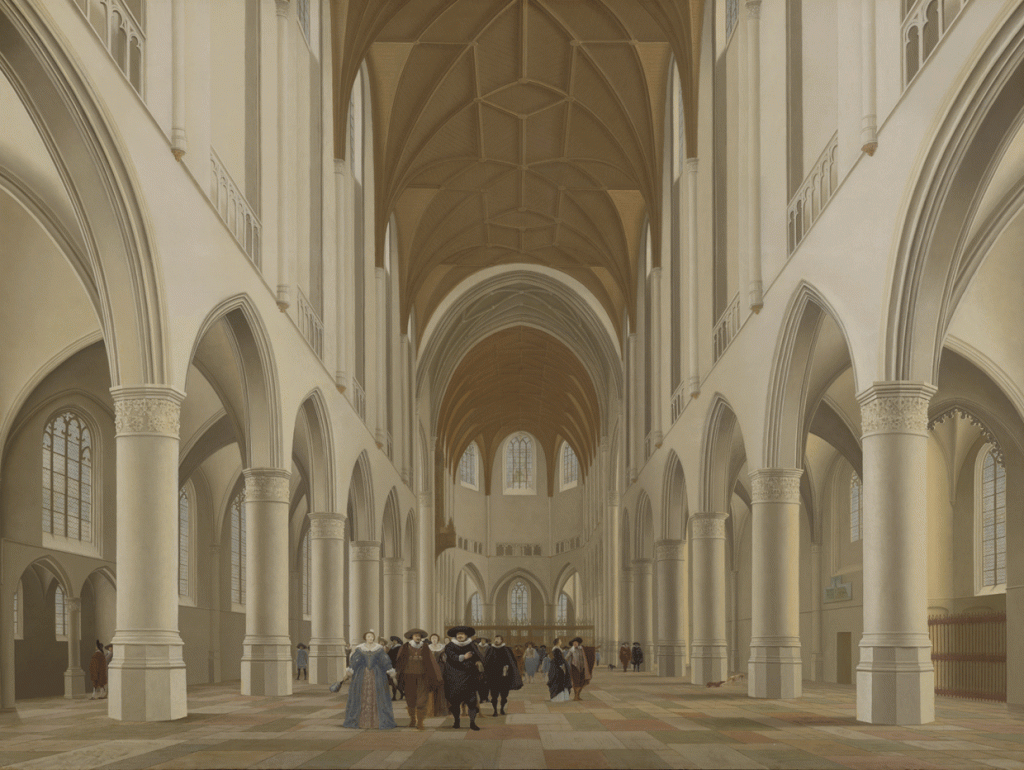 Interior of Saint Bavo, Haarlem, 1631. Pieter Jansz. Saenredam, Dutch (active Haarlem and Utrecht). Oil on panel, 32 5/8 x 43 1/2 inches. Philadelphia Museum of Art, John G. Johnson Collection, 1917.
Interior of Saint Bavo, Haarlem, 1631. Pieter Jansz. Saenredam, Dutch (active Haarlem and Utrecht). Oil on panel, 32 5/8 x 43 1/2 inches. Philadelphia Museum of Art, John G. Johnson Collection, 1917.
Eight paintings in the exhibition illustrate some of the fascinating breakthroughs in understanding that have emerged from curators’ and conservators’ work researching and caring for the collection over time. Among them is Rogier van der Weyden’s Crucifixion, with Virgin and Saint John the Evangelist Mourning, from around 1460. This pair of wood panels long puzzled scholars, who were uncertain whether they were created as part of an altarpiece or as an independent work. A conservator’s close technical study eventually led to the realization that they had served as shutters that closed over what was likely one of the largest altarpieces made during the Renaissance in northern Europe; its existence is known only through the Johnson Collection paintings and two others discovered in 2012.
 The Crucifixion, c. 1460. Rogier van der Weyden, Netherlandish (active Tournai and Brussels). Oil on panel, 71 x 36 7/16 inches. Philadelphia Museum of Art, John G. Johnson Collection, 1917.
The Crucifixion, c. 1460. Rogier van der Weyden, Netherlandish (active Tournai and Brussels). Oil on panel, 71 x 36 7/16 inches. Philadelphia Museum of Art, John G. Johnson Collection, 1917.
Descent from the Cross, painted by the Netherlandish artist Joos van Cleve around 1520, has undergone a year-long conservation treatment and is placed on view for the first time in thirty years. Once considered to be simply a copy of a major painting of the same subject created by Rogier van der Weyden eight decades earlier, it remained in storage as a study picture. The painting is now considered to be Joos van Cleve’s homage to this revered masterpiece.
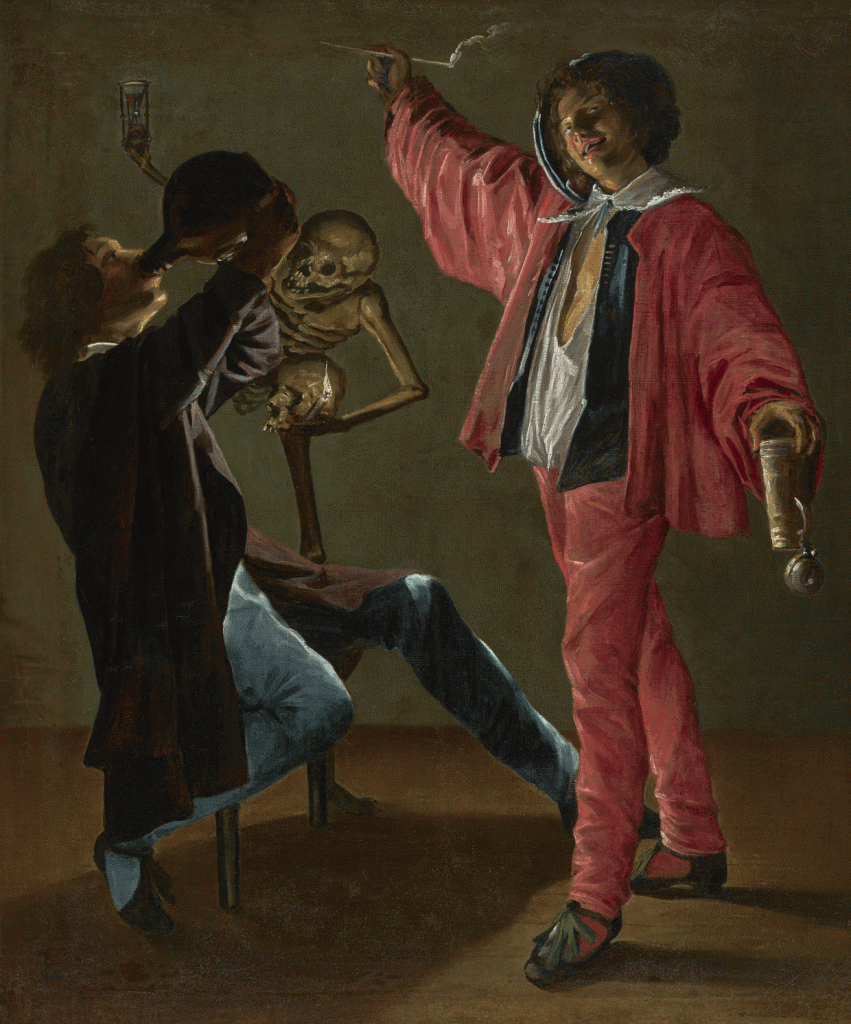 The Last Drop (The Gay Cavalier), c. 1639. Judith Leyster, Dutch (active Haarlem and Amsterdam). Oil on canvas, 35 1/16 x 28 15/16 inches. Philadelphia Museum of Art, John G. Johnson Collection, 1917.
The Last Drop (The Gay Cavalier), c. 1639. Judith Leyster, Dutch (active Haarlem and Amsterdam). Oil on canvas, 35 1/16 x 28 15/16 inches. Philadelphia Museum of Art, John G. Johnson Collection, 1917.
Another work that illustrates how historical and technical study may recover an artist’s original meaning is Dutch master Judith Leyster’s painting The Last Drop (The Gay Cavalier). Dating to about 1629, it depicts a scene of two men approaching the end of a night of drinking. In 1979 an art historian discovered an early copy of the painting that included a skeleton—a warning to the revelers that they should change their ways. The Johnson painting showed no skeleton, but a conservator’s examination and microscopic cleaning tests in 1992 determined that it once had been painted over and it remained beautifully intact. Removal of the overpainting, documented in a series of photographs, revealed the true message of Leyster’s painting.
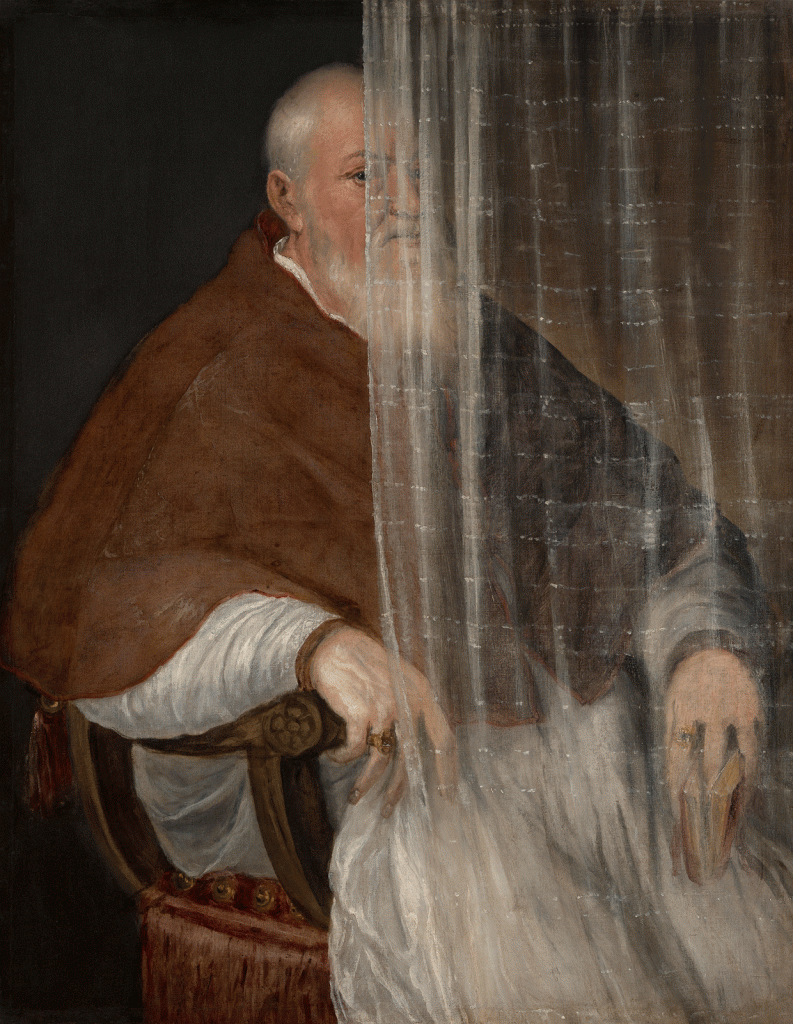 Portrait of Archbishop Filippo Archinto, 1558. Titian (Tiziano Vecellio), Italian (active Venice). Oil on canvas, 45 3/16 x 34 15/16 inches. Framed: 58 3/4 × 48 1/4 × 5 inches. Philadelphia Museum of Art, John G. Johnson Collection, 1917. Post-conservation image, 2017.
Portrait of Archbishop Filippo Archinto, 1558. Titian (Tiziano Vecellio), Italian (active Venice). Oil on canvas, 45 3/16 x 34 15/16 inches. Framed: 58 3/4 × 48 1/4 × 5 inches. Philadelphia Museum of Art, John G. Johnson Collection, 1917. Post-conservation image, 2017.
Titian’s enigmatic Portrait of Archbishop Filippo Archinto of 1558 has been newly cleaned and restored following years of study and conservation treatment. It is presented alongside a display illustrating how the artist’s original materials have changed with age. Recent analysis by Museum conservators and scientists revealed that Titian painted Archinto with a purple cloak, a color identified with archbishops. The blue pigment that contributed to the purple hue deteriorated over time, making the cloak appear red today. This discovery adds insight into how Titian’s contemporaries would have seen this masterful portrait.
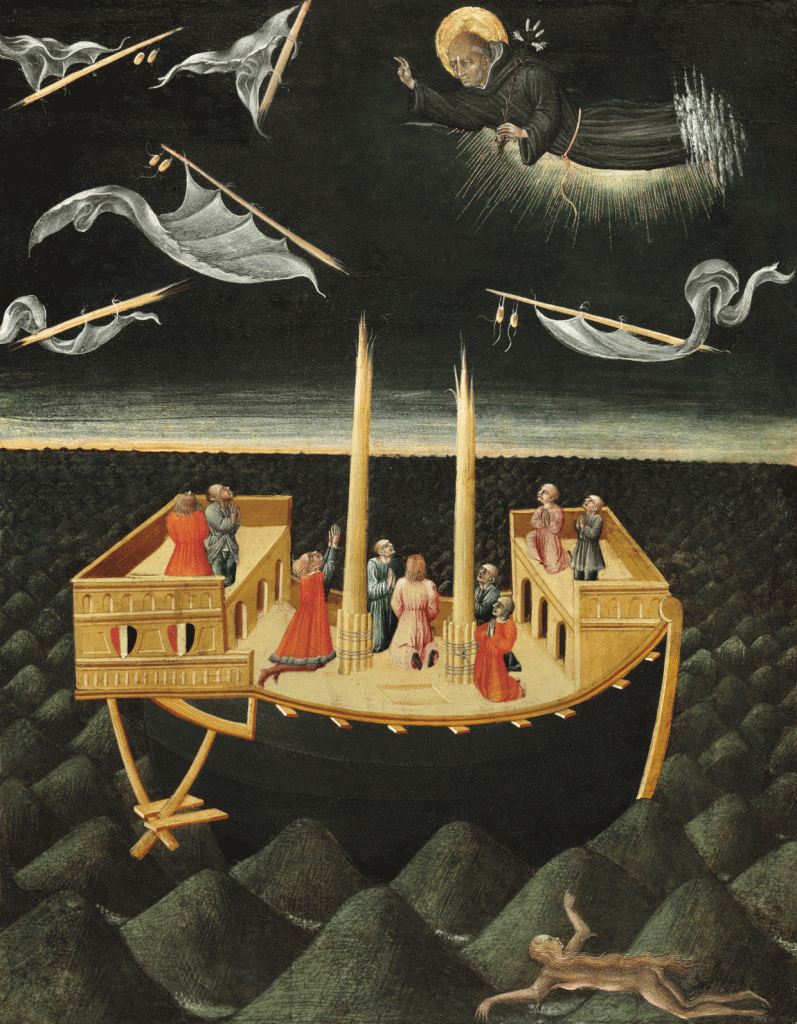 Saint Nicholas of Tolentino Saving a Shipwreck, 1457. Giovanni di Paolo (Giovanni di Paolo di Grazia), Italian (active Siena). Tempera and gold on panel with vertical grain, 20 1/2 x 16 5/8 inches. Philadelphia Museum of Art, John G. Johnson Collection, 1917.
Saint Nicholas of Tolentino Saving a Shipwreck, 1457. Giovanni di Paolo (Giovanni di Paolo di Grazia), Italian (active Siena). Tempera and gold on panel with vertical grain, 20 1/2 x 16 5/8 inches. Philadelphia Museum of Art, John G. Johnson Collection, 1917.
Attribution is examined in the section devoted to the Dutch master Hieronymus Bosch. Johnson was among the earliest Americans to collect Bosch, and today the Museum is among only a handful in the United States that possess a work by this great painter. Although Johnson purchased 10 works that he understood to be by the artist, close comparative looking and technical research—most notably through the use of dendrochronology (dating growth rings in wood)—has led to the conclusion that only one can be considered authentic today.
Mark Tucker, The Neubauer Family Director of Conservation, said, “The work that goes on in conservation is at the very heart of the Museum’s commitment to expanding the understanding of the art in its care. We are looking forward to sharing with visitors not just the results of that work, but also the processes of investigation and the excitement of discovery.”
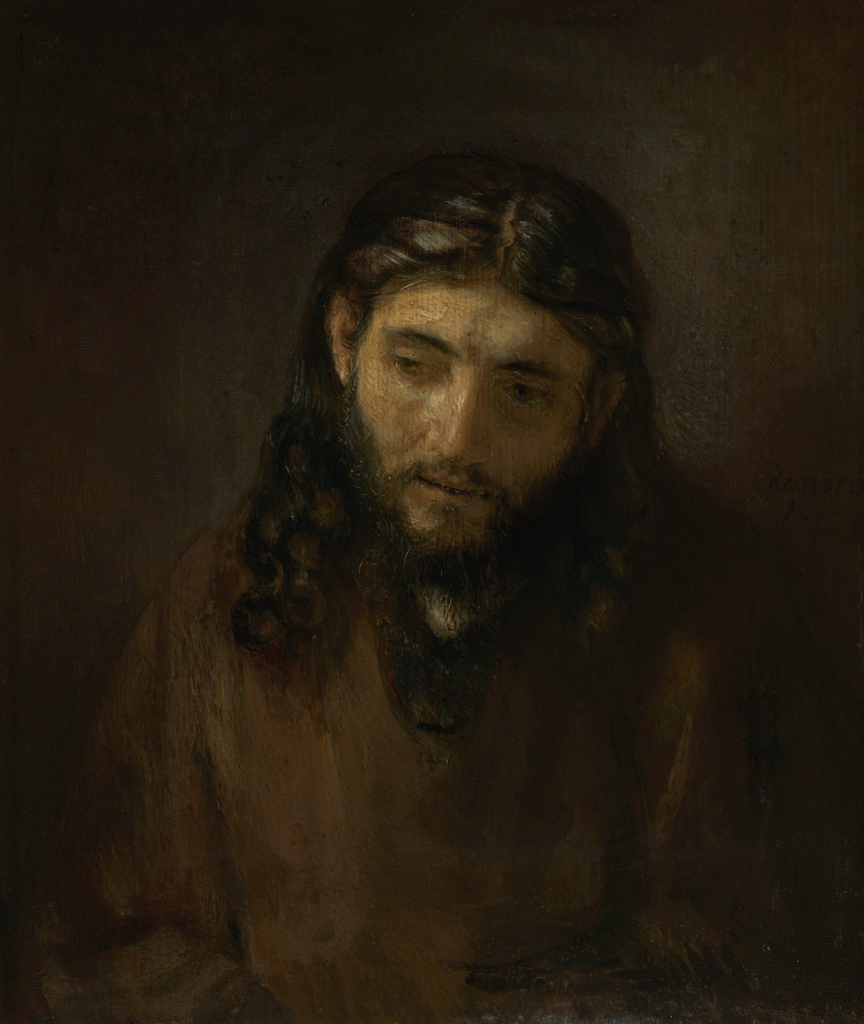 Head of Christ, c. 1648‑1656. Rembrandt Harmensz. van Rijn, Dutch (active Leiden and Amsterdam), 1606 ‑ 1669. Oil on oak panel, laid into larger oak panel, 14 1/8 x 12 5/16 inches. Framed: 28 1/4 x 23 x 2 inches. Philadelphia Museum of Art, John G. Johnson Collection, 1917.
Head of Christ, c. 1648‑1656. Rembrandt Harmensz. van Rijn, Dutch (active Leiden and Amsterdam), 1606 ‑ 1669. Oil on oak panel, laid into larger oak panel, 14 1/8 x 12 5/16 inches. Framed: 28 1/4 x 23 x 2 inches. Philadelphia Museum of Art, John G. Johnson Collection, 1917.
The exhibition also explores those areas of European painting in which Johnson focused in depth, including Italian, Dutch and Netherlandish, and French art. The number of Dutch paintings he acquired was among the largest of his day, and is especially rich in landscapes by Jacob van Ruisdael and animated genre scenes by Jan Steen. Rembrandt’s Head of Christ is also on view in this section.
 Christ and the Virgin, c. 1430‑1435. Robert Campin, also called the Master of Flémalle, Netherlandish (active Tournai). Oil and gold on panel, 11 1/4 x 17 15/16 inches. Philadelphia Museum of Art, John G. Johnson Collection, 1917.
Christ and the Virgin, c. 1430‑1435. Robert Campin, also called the Master of Flémalle, Netherlandish (active Tournai). Oil and gold on panel, 11 1/4 x 17 15/16 inches. Philadelphia Museum of Art, John G. Johnson Collection, 1917.
One section devoted to some of the earliest works in Johnson’s collection explores how art historians and conservators evaluate the original context of works that today exist only as fragments of a larger whole. Here an image of the Sienese artist Duccio’s great altarpiece called the Maestá will be placed beside his workshop’s Angel, showing how it was placed and functioned within the larger composition. Other fragmentary works on view include four small superb paintings by Botticelli and Fra Angelico’s Saint Francis of Assisi.
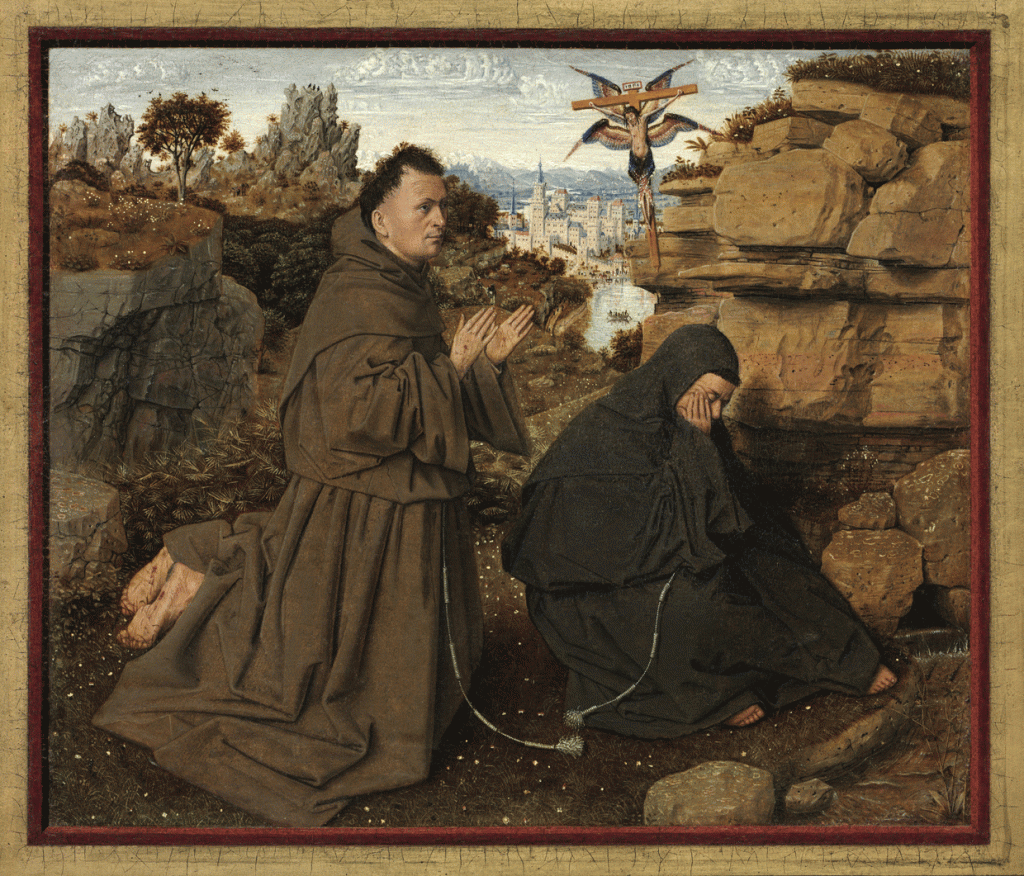 Saint Francis of Assisi Receiving the Stigmata, 1430‑1432. Jan van Eyck, Netherlandish (active Bruges). Oil on vellum on panel, 5 x 5 3/4 inches. Philadelphia Museum of Art, John G. Johnson Collection, 1917.
Saint Francis of Assisi Receiving the Stigmata, 1430‑1432. Jan van Eyck, Netherlandish (active Bruges). Oil on vellum on panel, 5 x 5 3/4 inches. Philadelphia Museum of Art, John G. Johnson Collection, 1917.
Another section is devoted to Johnson’s fascination with the art of his time. It highlights Édouard Manet’s Battle of the USS “Kearsarge” and the CSS “Alabama”, James Abbott McNeill Whistler’s Purple and Rose: The Lange Leizen of the Six Marks, and major paintings by John Constable, Gustave Courbet, Edgar Degas, Winslow Homer, Camille Pissarro, and Eduard Charlemont, and a marble by Auguste Rodin.
 The Descent from the Cross, c. 1518‑1520. Joos van Cleve, Netherlandish (active Antwerp and France). Oil on panel, 45 1/4 x 49 3/4 inches. Philadelphia Museum of Art, John G. Johnson Collection, 1917. Post-conservation image, 2017.
The Descent from the Cross, c. 1518‑1520. Joos van Cleve, Netherlandish (active Antwerp and France). Oil on panel, 45 1/4 x 49 3/4 inches. Philadelphia Museum of Art, John G. Johnson Collection, 1917. Post-conservation image, 2017.
During the presentation of the exhibition the Johnson curatorial and conservation team will be frequently available in the galleries to give talks and answer questions. Visitors are encouraged to explore the Museum’s European galleries, where other works from the Johnson Collection are installed, including a display of sculptures in gallery 273 and another devoted to embroideries and other textiles.
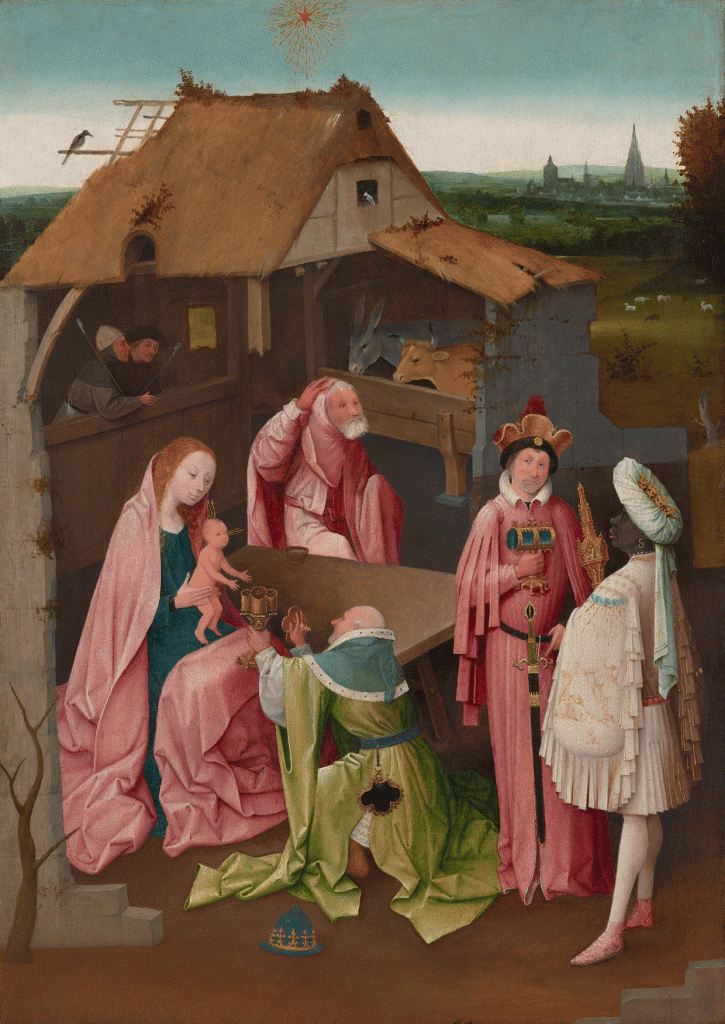 The Adoration of the Magi, Early 16th century. Hieronymus Bosch, Netherlandish (active Hertogenbosch). Oil on panel, 30 1/2 × 22 inches. Philadelphia Museum of Art, John G. Johnson Collection, 1917. Post-conservation image, 2015.
The Adoration of the Magi, Early 16th century. Hieronymus Bosch, Netherlandish (active Hertogenbosch). Oil on panel, 30 1/2 × 22 inches. Philadelphia Museum of Art, John G. Johnson Collection, 1917. Post-conservation image, 2015.
Jennifer Thompson, The Gloria and Jack Drosdick Curator of European Painting and Sculpture and Curator of the John G. Johnson Collection, said, “Our understanding of the Johnson Collection is constantly changing. This exhibition marks the first significant assessment of how our thinking on it has evolved over the years. While the careful study we have given to objects in the collection is rarely presented to the public, we are quite pleased to give visitors a behind-the-scenes look at the work we do.”
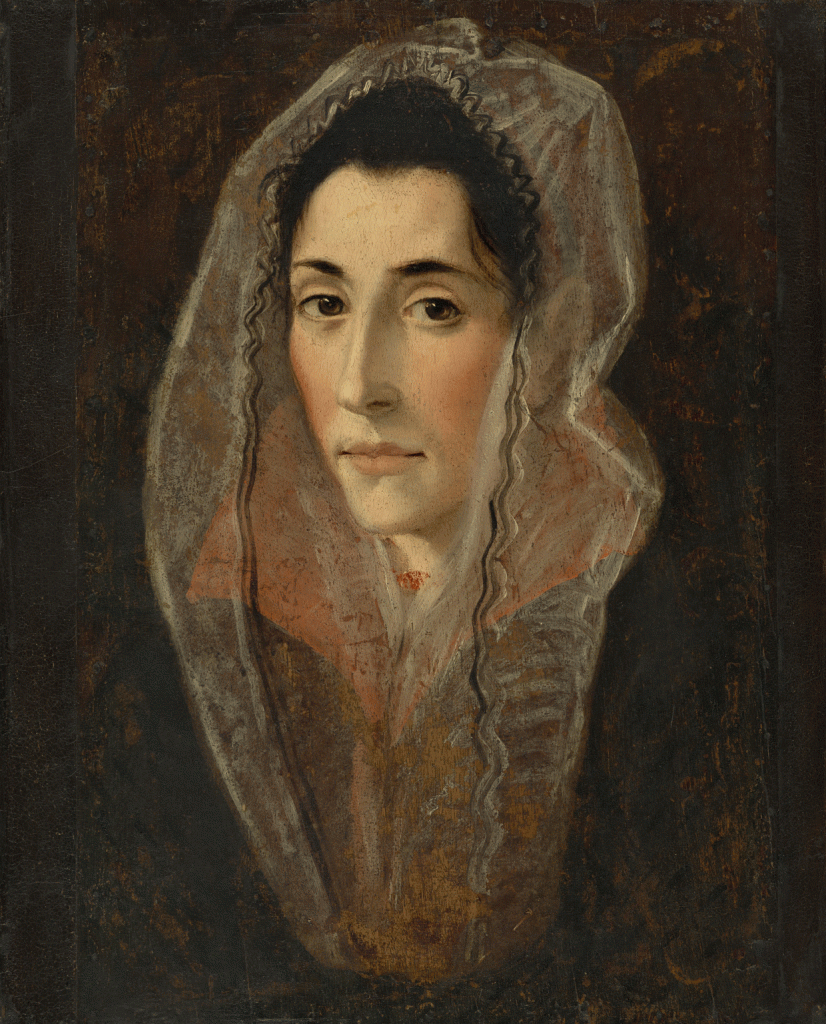 Portrait of a Lady, c. 1577‑1580. Attributed to El Greco (Domenikos Theotokopoulos), Spanish (born Crete, active Italy and Spain). Oil on panel, 15 5/8 x 12 5/8 inches. Philadelphia Museum of Art, John G. Johnson Collection, 1917.
Portrait of a Lady, c. 1577‑1580. Attributed to El Greco (Domenikos Theotokopoulos), Spanish (born Crete, active Italy and Spain). Oil on panel, 15 5/8 x 12 5/8 inches. Philadelphia Museum of Art, John G. Johnson Collection, 1917.
Digital Publication
On the occasion of the centenary of Johnson’s bequest to the City of Philadelphia, the Museum is producing its first digital publication, The John G. Johnson Collection: A History and Selected Works. The publication includes thematic essays written by the Museum’s curatorial and conservation teams that focus on the history of, scholarship on, and stewardship of the collection. Catalogue entries on seventy objects from the Johnson Collection integrate digitized archival resources, allowing scholars new ways to explore the histories of the artworks. It will be available for free and accessible to researchers and the public alike on February 1, 2018 (ISBN: 978-0-87633-276-4).
 The Battle of the U.S.S. “Kearsarge” and the C.S.S. “Alabama”, 1864. Édouard Manet, French. Oil on canvas, 54 1/4 x 50 3/4 inches. Philadelphia Museum of Art, John G. Johnson Collection, 1917.
The Battle of the U.S.S. “Kearsarge” and the C.S.S. “Alabama”, 1864. Édouard Manet, French. Oil on canvas, 54 1/4 x 50 3/4 inches. Philadelphia Museum of Art, John G. Johnson Collection, 1917.
The development of this catalogue is led by Christopher D. M. Atkins, The Agnes and Jack Mulroney Associate Curator of European Painting and Sculpture, and Manager of Curatorial Digital Programs and Initiatives; and Karina Wratschko, Special Projects Librarian. Atkins said, “We are connecting art information with archival information. This is the most groundbreaking aspect of the project as most institutions have treated these materials separately, until now.”
 Railroad Bridge, Argenteuil, 1874. Claude Monet, French. Oil on canvas, 21 3/8 x 28 7/8 inches. Philadelphia Museum of Art, John G. Johnson Collection, 1917.
Railroad Bridge, Argenteuil, 1874. Claude Monet, French. Oil on canvas, 21 3/8 x 28 7/8 inches. Philadelphia Museum of Art, John G. Johnson Collection, 1917.
The John G. Johnson Curatorial and Conservation Team
Jennifer Thompson, The Gloria and Jack Drosdick Curator of European Painting and Sculpture and Curator of the John G. Johnson Collection
Christopher D. M. Atkins, The Agnes and Jack Mulroney Associate Curator of European Painting and Sculpture, and Manager of Curatorial Digital Programs and Initiatives
Mark Tucker, The Neubauer Family Director of Conservation
Teresa Lignelli, The Aronson Senior Conservator of Paintings
Carl Brandon Strehlke, Curator Emeritus, John G. Johnson Collection
Joseph J. Rishel, Curator Emeritus, European Painting
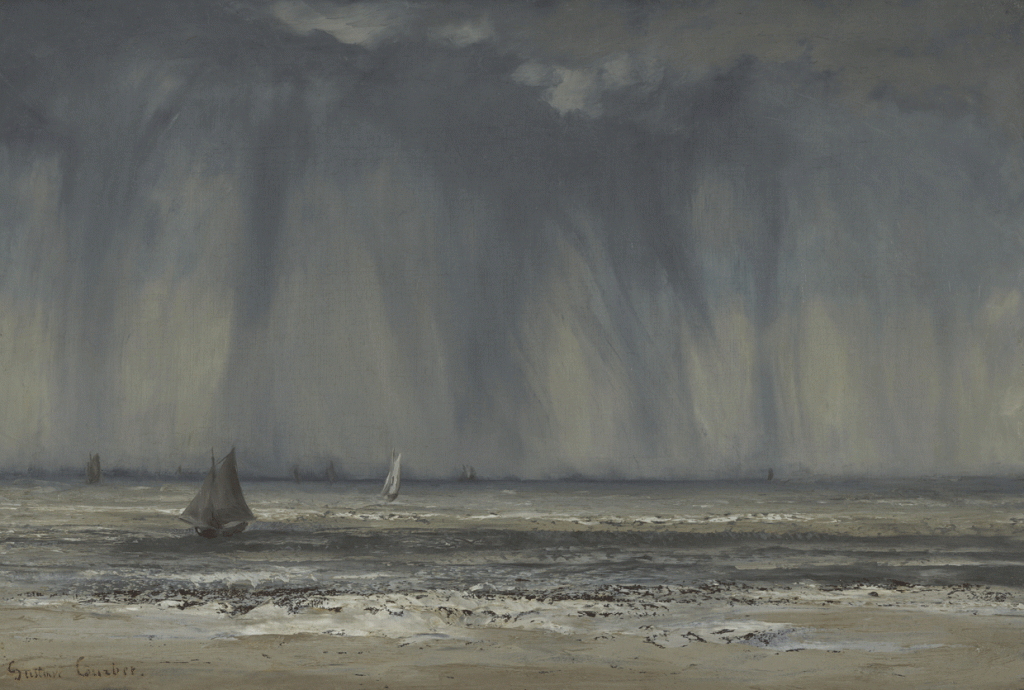 Marine, 1866. Gustave Courbet, French. Oil on canvas on gypsum board. Philadelphia Museum of Art, John G. Johnson Collection, 1917.
Marine, 1866. Gustave Courbet, French. Oil on canvas on gypsum board. Philadelphia Museum of Art, John G. Johnson Collection, 1917.
About John Graver Johnson (1841–1917)
Born in the village of Chestnut Hill, now part of Philadelphia, and educated in the city’s public Central High School and then at the University of Pennsylvania, Johnson became recognized as the greatest lawyer in the English-speaking world. He represented influential clients such as J. P. Morgan, US Steel, the Sugar Trust, and Standard Oil. He was also known to accept cases that many would consider ordinary if the details piqued his intellectual interest. Johnson quietly acquired many important works of art as well as highly singular ones that have been the source of much scholarly discussion.
At the age of 34 he married Ida Alicia Powel Morrell (1840–1908), a widow with three children. He traveled to Europe often, visiting France, Switzerland, Italy, Austria, Germany, and Belgium, and collected pictures as an amateur art historian relying on his own evaluation. In 1892 he published Sight-Seeing in Berlin and Holland among Pictures. Also that year, he published a catalogue of his collection, which at the time included 281 paintings.
In 1895 Johnson was appointed to Philadelphia’s Fairmount Art Commission where he oversaw the Wilstach Gallery, which housed a public collection of paintings. Under his leadership, the commission purchased important works, among them James McNeill Whistler’s Arrangement in Black and Henry Ossawa Tanner’s Annunciation, the first work by an African American artist to enter a public collection in the United States. Johnson was also the attorney for Alexander Cassatt, brother of the artist Mary Stevenson Cassatt. One of his earliest purchases was Cassatt’s On the Balcony. When Johnson gave this work to the Wilstach Gallery in 1906, it was the first painting by the artist to enter an American public collection. During his 22-year stewardship of the Wilstach Gallery, he made 53 gifts from his personal collection, which are now on view at the Philadelphia Museum of Art.
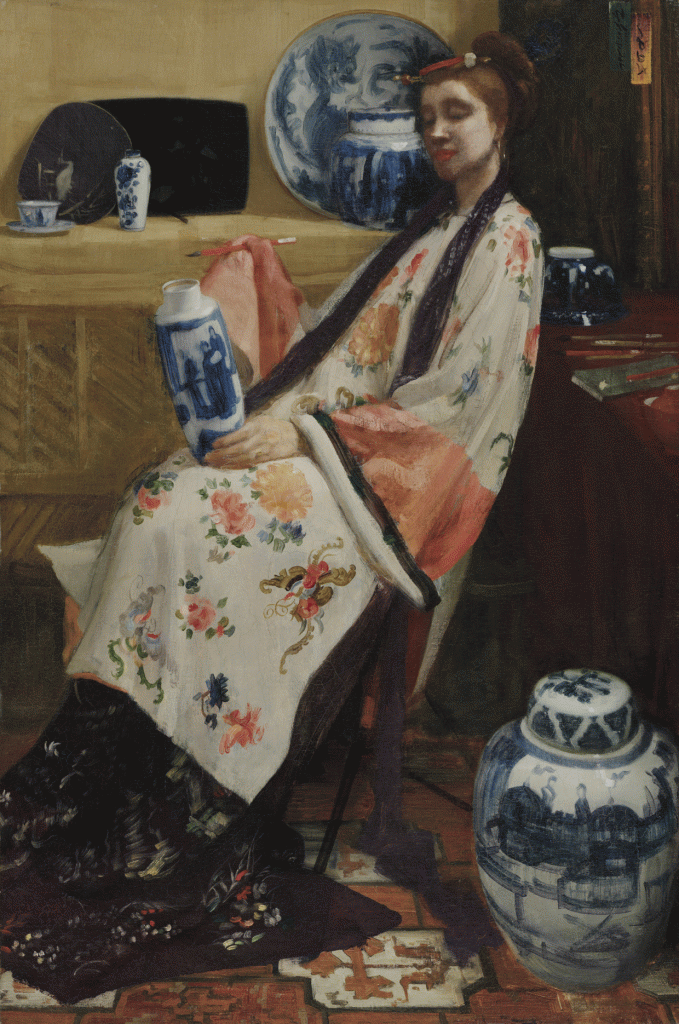 Purple and Rose: The Lange Leizen of the Six Marks, 1864. James Abbott McNeill Whistler, American (active England). Oil on canvas, 36 3/4 x 24 1/8 inches. Philadelphia Museum of Art, John G. Johnson Collection, 1917.
Purple and Rose: The Lange Leizen of the Six Marks, 1864. James Abbott McNeill Whistler, American (active England). Oil on canvas, 36 3/4 x 24 1/8 inches. Philadelphia Museum of Art, John G. Johnson Collection, 1917.
About the John G. Johnson Collection
Johnson’s collection was formed through his own study and, in later years, with the assistance of illustrious art historians including Roger Fry and Wilhelm Valentiner. Bernard Berenson advised his purchases of works by, among others, Antonello da Messina, Sandro Botticelli, and Pietro Lorenzetti. To this day, the John G. Johnson Collection is distinguished by its quality, rarity, and diversity in European art.
At the time of his death on April 14, 1917, Johnson left his collection to the City of Philadelphia. In his will, he said, “I have lived my life in this City. I want the collection to have its home here.” The City of Philadelphia accepted the conditions of his will, which contained a codicil directing that his house be opened as a gallery for the public to enjoy. In 1933 the Johnson Collection was moved temporarily from Johnson’s house at 510 South Broad Street to the Philadelphia Museum of Art, due to a funding crisis caused by the Great Depression as well as a determination by a court-appointed master that the Johnson house was unsafe for the collection. In 1958 the Museum, the City, and the Johnson Trust entered a formal agreement concerning storage and display of the Johnson Collection at the Museum. Johnson’s art was exhibited as a separate collection within the Museum for more than 50 years. In the late 1980s, legal approval was granted for the Museum to integrate the works into its full collection. The collection numbers 1,279 paintings, 51 sculptures, and over 100 other objects.
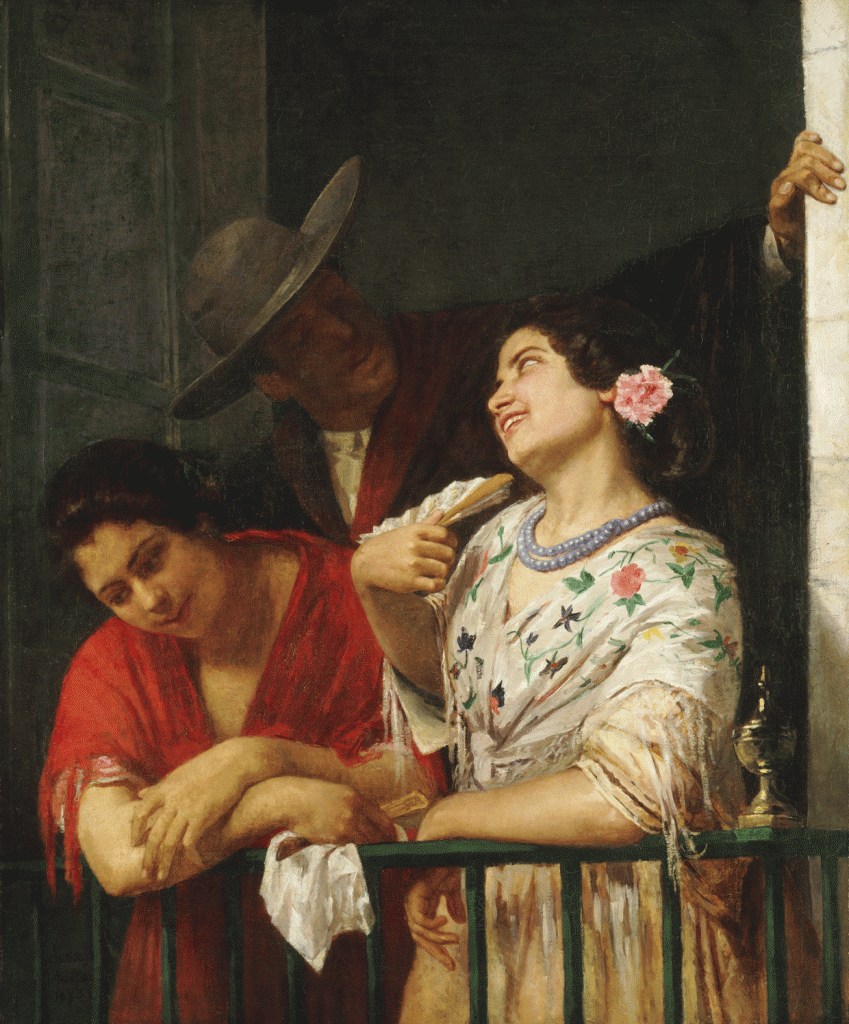 On the Balcony, 1873. Mary Stevenson Cassatt, American. Oil on canvas, 39 3/4 × 32 1/2 inches. Philadelphia Museum of Art, Gift of John G. Johnson for the W. P. Wilstach Collection, 1906.
On the Balcony, 1873. Mary Stevenson Cassatt, American. Oil on canvas, 39 3/4 × 32 1/2 inches. Philadelphia Museum of Art, Gift of John G. Johnson for the W. P. Wilstach Collection, 1906.
Support
This exhibition has been made possible by The Annenberg Foundation Fund for Major Exhibitions, The Robert Montgomery Scott Endowment for Exhibitions, The Women’s Committee of the Philadelphia Museum of Art, the Kowitz Family Foundation, Friends of Heritage Preservation, Lawrence H. and Julie C. Berger, The Jill and Sheldon Bonovitz Exhibition Fund, The Gloria and Jack Drosdick Fund for Special Exhibitions, The Harriet and Ronald Lassin Fund for Special Exhibitions, The Robert Lehman Foundation, James and Susan Pagliaro, Lyn M. Ross, Saul Ewing Arnstein & Lehr LLP, and Joan F. Thalheimer.
Support for the accompanying digital publication has been provided by Lois G. and Julian A. Brodsky, Martha Hamilton Morris and I. Wistar Morris III, an anonymous donor, and other generous individuals.
 The Moorish Chief, 1878. Eduard Charlemont, Austrian. Oil on panel, 59 1/8 x 38 1/2 inches. Philadelphia Museum of Art, John G. Johnson Collection, 1917.
The Moorish Chief, 1878. Eduard Charlemont, Austrian. Oil on panel, 59 1/8 x 38 1/2 inches. Philadelphia Museum of Art, John G. Johnson Collection, 1917.
Social media: To follow the conversation on social media use the hashtag #OldMastersNow
Facebook: philamuseum; Twitter: philamuseum; Tumblr: philamuseum; YouTube: PhilaArtMuseum; Instagram: @philamuseum
The Philadelphia Museum of Art is Philadelphia’s art museum. We are a landmark building. A world-renowned collection. A place that welcomes everyone. We bring the arts to life, inspiring visitors—through scholarly study and creative play—to discover the spirit of imagination that lies in everyone. We connect people with the arts in rich and varied ways, making the experience of the Museum surprising, lively, and always memorable. We are committed to inviting visitors to see the world—and themselves—anew through the beauty and expressive power of the arts.
For additional press information contact the press office at 215-684-7860 or pressroom@philamuseum.org. For general information, call 215-763-8100 or visit philamuseum.org.
Thank you to the Philadelphia Museum of Art for the content of this post. Click the pictures for large images.
SEO and Photoshop by DoN.
Like DoNArTNeWs Philadelphia Art News Blog on facebook
Follow the new DoNArTNeWs.com
Follow DoN on Twitter @DoNNieBeat58
DoN Brewer on Pinterest
@donniebeat on Instagram
Affiliate Marketing [disclosure page] Shop on-line and help support DoNArTNeWs



